
by Julia Rosen Tuesday, April 7, 2015
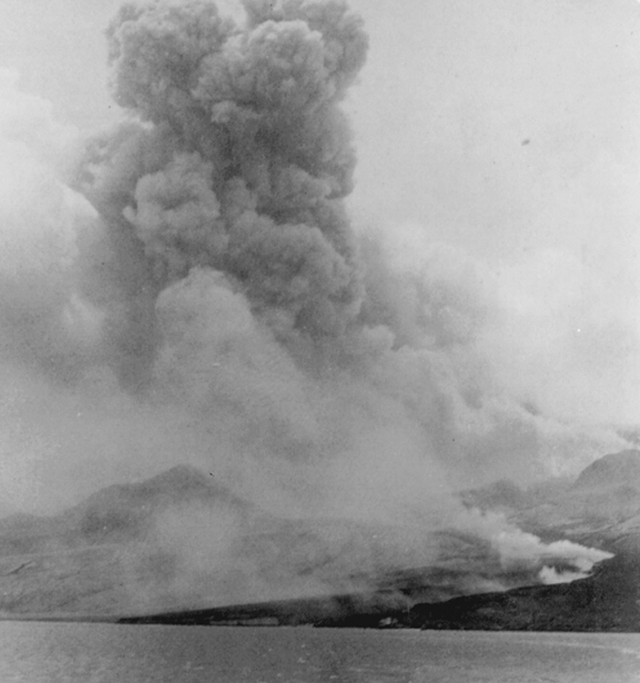
The volcanic eruption of Mount Pelée on Martinique in 1902. Credit: Library of Congress.
At the turn of the 20th century, the town of St. Pierre was known as the “Paris of the Caribbean.” Nestled into the northwest coast of the French island of Martinique, it boasted a bustling harbor where ships hauled away precious loads of sugar and rum, and it had usurped the official capital — Fort-de-France — as the colony’s cultural center. But St. Pierre had a problem: it lay in the shadow of a massive volcano.
Like most of the Lesser Antilles, Martinique was built by volcanoes. It’s part of an active island arc that traces the boundary where oceanic crust subducts beneath the Caribbean Plate, forming a lush, perforated barrier between the Caribbean Sea and the Atlantic Ocean.
One of these volcanoes, Mount Pelée, sat just 7 kilometers from St. Pierre and soared almost 1,400 meters above the city. Its smooth, verdant slopes lumbered down to the sea, cut in places by deep, raw gashes. Its summit crater drew adventurous hikers who occasionally caught whiffs of putrid gases. But, as far as the residents of St. Pierre knew, Mount Pelée was a gentle giant. The volcano had creaked and grunted back in 1792, and had showered the northern lobe of Martinique with fine ash once in 1851. But after a few more coughs and some minor mudslides, Pelée fell quiet for half a century.
When it roared to life again in 1902, the mountain produced one of the deadliest eruptions in recorded history, unleashing a cascade of horrors upon the residents of St. Pierre before obliterating the town in one fatal instant. It would also revolutionize geologists’ understanding of how volcanoes work and the kinds of danger they pose.
In April 1902, the first signs of Pelée’s reawakening were subtle: a string of small tremors rattled St. Pierre, and clouds of sulfurous fumes wafted down from the mountain. Other signs were just plain mysterious, like the rupture of an underwater telegraph cable connecting Martinique to nearby Dominica, or the sudden appearance of a lake in the caldera.
On the night of May 2, however, a small eruption commanded the town’s attention. Witnesses said Pelée’s summit seemed to catch fire, spewing glowing rocks and rendering the midnight sky incandescent. The next morning, residents found birds that had plummeted from the air, weighted down by ash, and a steamer captain noticed dead fish floating in the sea, possibly killed by the shockwave of a submarine earthquake.
Over the following days, the mountain continued to fume, driving terrified people from the countryside into St. Pierre, which the newspapers reported was safe. Even there, however, things were amiss: The Rivière Blanche on Pelée’s southwest flank, which emptied into the sea just north of town, had been fluctuating wildly, sometimes overtopping its banks, other times disappearing completely. No one suspected that these convulsions stemmed from magma rising from the bowels of the volcano and affecting groundwater. Yet, these unsettling omens did not go completely unnoticed by the town’s residents.
“This morning the whole population of the city is on the alert, and every eye is directed toward Mount Pelée, an extinct volcano,” wrote Clara Prentiss, the wife of the American consul in St. Pierre, in a letter to her sister. “Everybody is afraid that the volcano has taken into its head to burst forth and destroy the whole island.”
In fact, on May 5, events took a deadly turn when a massive lahar broke through the crater wall and came screaming down the Rivière Blanche at speeds topping 100 kilometers per hour. A devastating mixture of mud and hot water, the slide destroyed a sugar processing plant on the coast, killing almost two dozen people. The debris then spilled into the ocean, producing a 3-meter-high tsunami that inundated St. Pierre.
Perhaps most horrifying of all, though, was the plague of insects and snakes that slithered down from the mountain, disturbed by its paroxysms. Among the invaders were gigantic centipedes and deadly 2-meter long pit vipers, which claimed the lives of hundreds of livestock and about 50 people, according to some accounts. Soldiers shot the serpents in the streets in what would turn out to be a futile effort to protect the people of St. Pierre.
Pelée’s eruption continued to intensify. On May 6, blue flames heralded the arrival of magma in the crater as a lava dome poked above its rim. On May 7, the mountain sputtered and a volcano on neighboring St. Vincent exploded, killing 1,500 people. The authorities, however, insisted there was nothing to fear. The very same day, members of a commission appointed by the island’s governor — whose leading expert was a high school science teacher — told the local paper that Mount Pelée presented no danger.
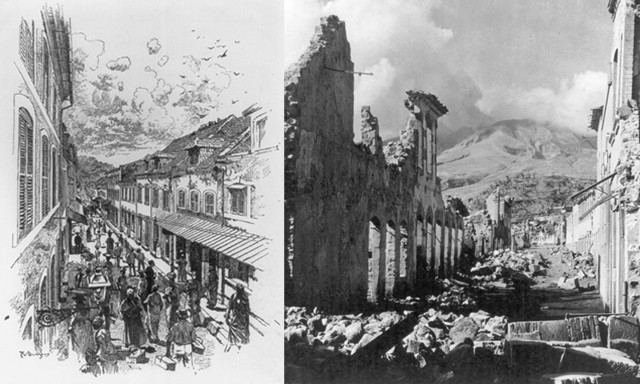
Rue Victor Hugo, one of the principal business streets in St. Pierre, known as the "Paris of the Caribbean," is illustrated in a wood engraving before, and seen in a photo after, the 1902 eruption of Mount Pelée. Credit: both: Library of Congress.
There’s debate about exactly what happened on May 8 — Ascension Day — but one thing is certain: In the course of a few short minutes, an infernal blast of hot gas and volcanic debris obliterated St. Pierre. Moments later, all but a handful of its nearly 30,000 residents were dead, including the governor, who had come with his family to reassure the population. Most of the victims perished from suffocation and burns that scorched their skin and lungs. (Subsequent analyses based on burnt wood yielded temperature estimates suggesting the gas cloud was between 350 and 400 degrees Celsius.)
One witness, Victor Albert, watched the explosion from his field and described the ensuing events to the French newspaper La Croix: “A flash more dazzling than a lightning happened … At the same time, a cloud that formed on the summit of Montagne [Mount] Pelée literally fell on Saint-Pierre with such rapidity that it was impossible for anyone to escape.”
The explosion leveled the town, hurling massive stone statues several meters from their perches — implying the cloud reached speeds exceeding 100 meters per second — and sparing only some walls oriented parallel to the blast. For days afterward, St. Pierre burned. Ships in the harbor smoldered and sank. When rescuers eventually did enter the ruins, they pulled from a jail cels survivor of the disaster, Louis-Auguste Cyparis, who later toured with the Barnum and Bailey Circus.
But as the smoke cleared, scientists began to wonder what exactly happened on Mount Pelée. Geologists had only a rudimentary understanding of volcanology at the time, based almost entirely on the historical eruptions of Italy’s Mount Vesuvius, accorch geologist Jean-Claude Tanguy. In a 1994 paper, he argued that this may explain why no one thought to evacuate St. Pierre in the days before the eruption — the impending calamity was simply beyond comprehension.
The catastrophe led geologists to invent a term for the blast that destroyed the city. Alfred Lacroix, a member of the French Geological Survey who wrote the most comprehensive account of the disaster in 1904, dubbed the phenomenon a “nuée ardente,” meaning glowing or burning cloud. In modern parlance, geologists would categorize this deadly mix of hot gas and rock as a type of pyroclastic flow, examples of which have since been observed during other volcanic eruptions, including Mount St. Helens in 1980.
For the better part of the following century, however, geologists debated what produced Pelée’s nuée ardente. Some said the eruption broke through the newly formed lava dome and spilled sideways out of the lowest point of the crater, which faced St. Pierre. Others said a massive column first rose high into the air, then collapsed under its own weight. With only eyewitness accounts and deposits of erupted material to go on, scientists have struggled to resolve the question.
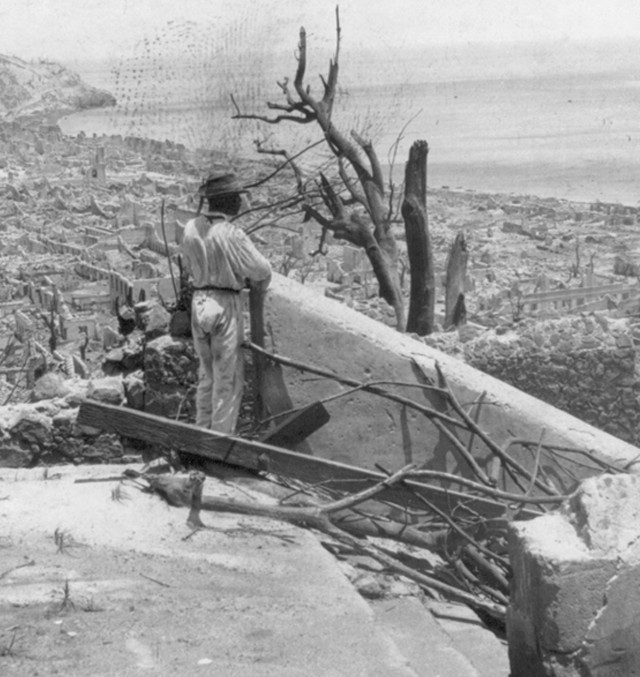
Overlooking the destruction of St. Pierre and the bay. Credit: Library of Congress.
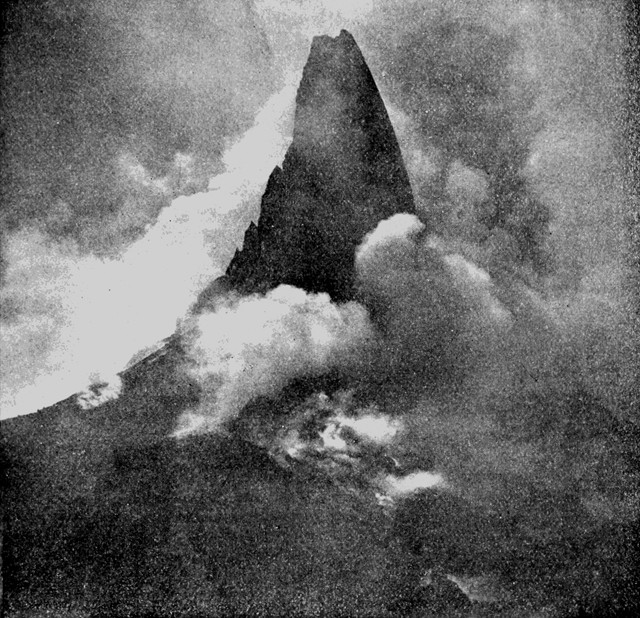
The tower of Mount Pelée rose after the eruption, eventually reaching 350 meters above the crater rim. Credit: Angelo Heilprin, public domain.
Throughout the summer of 1902, Pelée’s unrest continued. On May 20, another nuée ardente engulfed the ruins of St. Pierre, and on Aug. 30, an eruption destroyed the village of Morne Rouge, killing another 1,000 to 1,500 people. However, the most obvious sign of the volcano’s ongoing activity was the obelisk-shaped lava dome that had begun to rise vigorously from the caldera.
“None of the grand scenes of nature which I had before seen — the Matterhorn, the Domes of the Yosemite, the colossus of Popocatépetl soaring above the shoulder of Iztaccihuatl, or the Grand Cañon of the Colorado — impressed me to the extent that did the view of Pelée’s tower,” wrote Angelo Heilprin in 1904. Heilprin was a Hungarian-born American geologist who studied Mount Pelée in the years following the disaster, and became particularly fascinated with the tower.
In a 1903 letter to Science, Heilprin reports that the spine, just over a hundred meters wide at the base, grew at astonishing rates. It rose 10 meters during one eight-day period and 6 meters in another span of four days, and at its peak, loomed 350 meters above the rim of the crater. Through cracks in the rock, lava could sometimes be seen glowing inside the tower, and once, Heilprin observed steam rising from the summit, “suggesting a continuous passage or channel extending from base to summit.” The tower eventually crumbled in the spring of 1903, but not before Heilprin had captured stunning images that cemented its place in the geologic record books.
Although they could not rival the grandeur of the first, similar spines emerged again on the summit of Mount Pelée during later periods of eruptions, including a sustained bout between 1929 and 1932. These domes, and their calamitous collapses, were observed by the American volcanologist Frank Perret, who established a makeshift observatory less than 3 kilometers from the summit. From there, he documented pyroclastic flows as they spilled past his cabin, sometimes only narrowly sparing him.
Since then, however, Mount Pelée hasn’t made a peep. The Institute of Earth Physics in Paris currently operates a monitoring station on Martinique, which remains part of France. The station is equipped with a network of seismometers to catch any hint of volcanic activity.
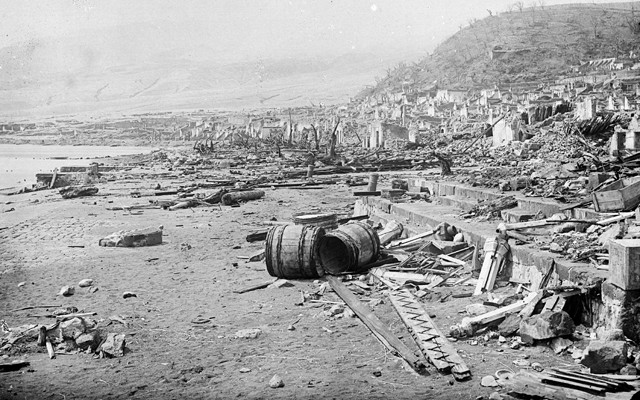
view of the shoreline at St. Pierre after the 1902 eruption, which killed 30,000 people. Credit: Tempest Anderson Photographic Archive at York Museums Trust.
A century of research into Pelée’s history, dating back millennia, has revealed the mountain can be violent and unpredictable, exhibiting many different eruptive styles over different time scales. Still, the 1902 eruption stands out for its sheer ferocity and the magnitude of the tragedy it produced. It ranks as the deadliest volcanic disaster of the 20th century, and the third deadliest in recorded history, after the 1815 eruption of Tambora and the 1883 explosion of Krakatoa. However, Tanguy argues that Pelée’s eruption killed more people directly than either of these two volcanoes, whose devastation took many additional forms, including starvation, disease and tsunamis.
But thanks to the knowledge gained from studying Mount Pelée and its nuée ardentes, many lives have since been spared. And one thing is certain: When the mountain stirs again, geologists will be prepared.
*Update (6/4/18, 15:40 EDT): The second sentence of the second paragraph, which previously stated that the Lesser Antilles island arc “traces the boundary where the oceanic crust of the North American Plate subducts beneath the Caribbean Plate,” was updated to reflect current ambiguity in the location of the tecontic boundary between the North American and South American plates with respect to the subduction zone beneath the Lesser Antilles.
© 2008-2021. All rights reserved. Any copying, redistribution or retransmission of any of the contents of this service without the expressed written permission of the American Geosciences Institute is expressly prohibited. Click here for all copyright requests.